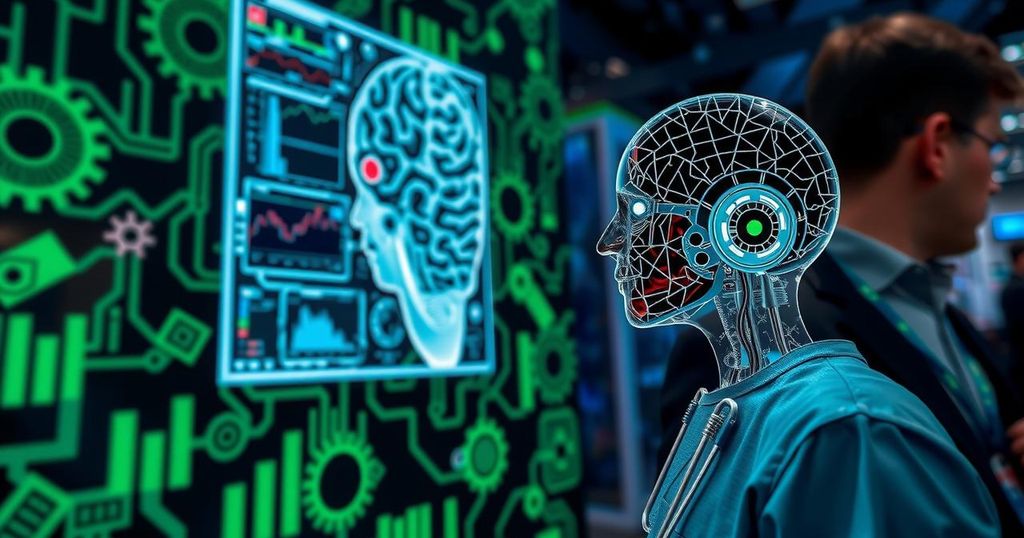Tech industry leaders are convening in Las Vegas for the HLTH conference to present AI-driven solutions that aim to reduce administrative workloads for healthcare workers, significantly contributing to clinician burnout. AI tools, such as Google’s Vertex AI and Microsoft’s DAX Copilot, promise efficiencies that could enhance patient care. These advancements may address the projected healthcare workforce shortages critical by 2028.
Leading tech firms, including Nvidia, Google, and Microsoft, are gathering in Las Vegas for the HLTH conference, a prominent healthcare technology event anticipated to attract over 12,000 industry leaders. This year’s focus will be on artificial intelligence (AI) tools designed to alleviate administrative burdens faced by healthcare professionals, a critical issue contributing to industry burnout and a looming workforce shortage of 100,000 healthcare workers by 2028, as reported by Mercer. Healthcare providers are confronted with extensive documentation requirements related to patient care, insurer interactions, and regulatory compliance, often hampered by fragmented data systems. To address these challenges, technology firms are advancing generative AI that promises not only to streamline administrative tasks but also to enhance overall workflow efficiency. Google has introduced Vertex AI Search for Healthcare to facilitate swift access to vital medical information across disparate records. According to a recent survey, clinicians reportedly spend nearly 28 hours weekly on administrative duties, detracting from patient interaction. Approximately 80% of healthcare providers expressed that such clerical responsibilities hinder their role in patient care, while 91% indicated a favorable outlook towards leveraging AI for task optimization. In parallel, Microsoft is unveiling tools specifically aimed at reducing the administrative workload for clinicians, including medical imaging models and automated documentation solutions. Microsoft’s existing DAX Copilot employs AI to convert recorded doctor-patient interactions into clinical documentation, saving time for physicians. For nurses, Microsoft is tailoring distinct documentation tools that align with their specific workflows. The rising popularity of AI scribe solutions is evident, with competitors like Abridge and Suki participating in the HLTH conference and attracting substantial investments. Nvidia is set to highlight its AI offerings at the conference, emphasizing innovations that allow healthcare professionals to devote more time to patient care. The company’s success in the AI sector has been significant, with GPU technology enabling cutting-edge applications like OpenAI’s ChatGPT, leading to a substantial increase in Nvidia’s stock. Despite the healthcare industry’s historical reluctance to embrace new technologies, the prevalent interest in AI for administrative tasks is reshaping the landscape, although many healthcare systems still navigate the initial phases of vendor evaluations and tool assessments.
The increasing burden of administrative tasks in healthcare contributes significantly to burnout and workforce shortages. Healthcare professionals struggle with extensive documentation necessary for patient records, insurance communications, and regulatory compliance. Emerging AI technologies are being developed by leading tech companies to streamline these processes, thereby enhancing productivity and potentially mitigating the anticipated shortage of healthcare workers by 2028. The HLTH conference serves as a platform for showcasing innovative AI solutions aimed at transforming healthcare administration and practice.
In summary, a gathering of major tech companies at the HLTH conference underscores the critical need for AI tools to alleviate administrative pressures in healthcare. The integration of technologies like Google’s Vertex AI and Microsoft’s DAX Copilot presents promising avenues to enhance operational efficiency. With substantial potential to reshape healthcare practice, these innovations may help counteract the burdens contributing to clinician burnout while addressing the impending workforce shortages.
Original Source: www.cnbc.com

Leave a Reply